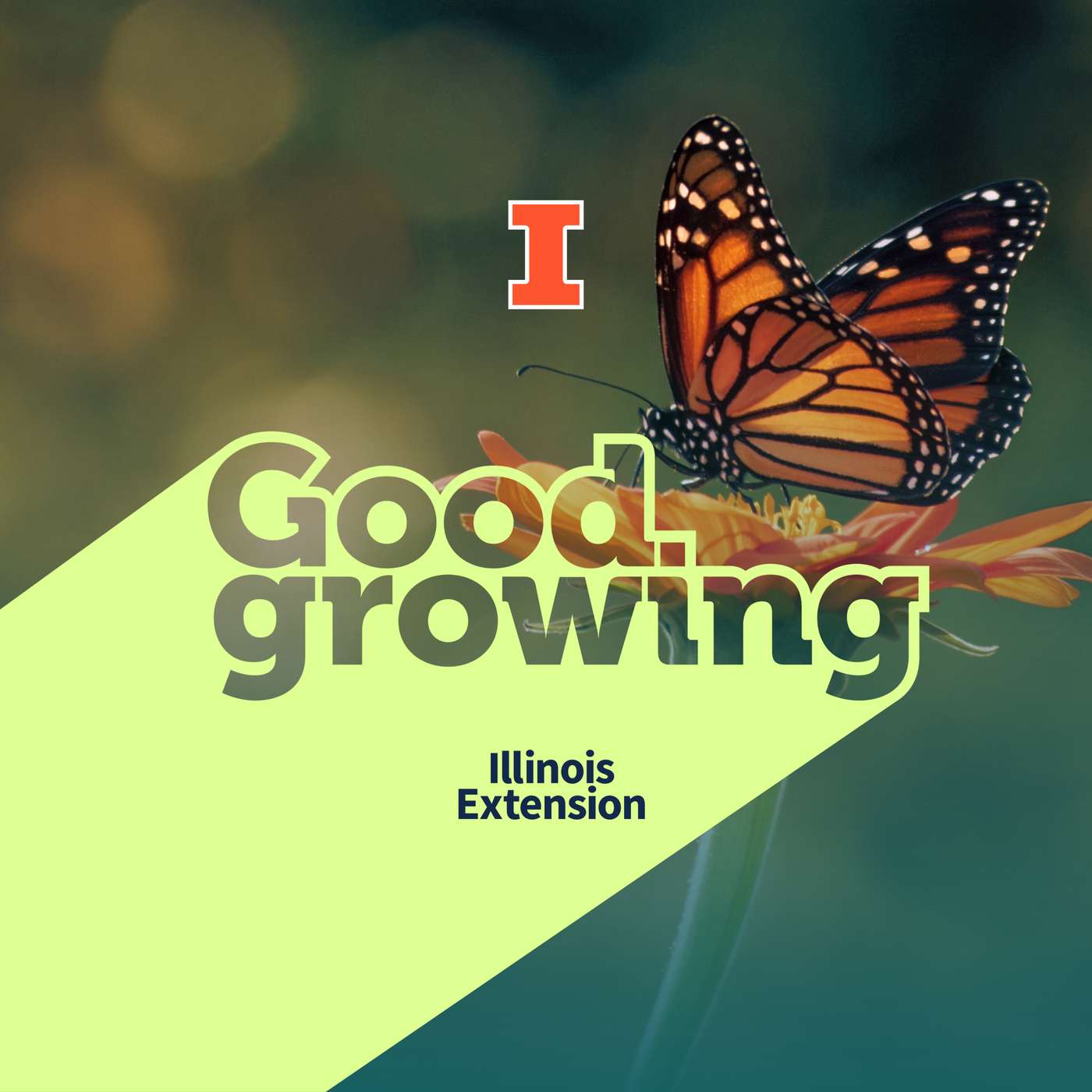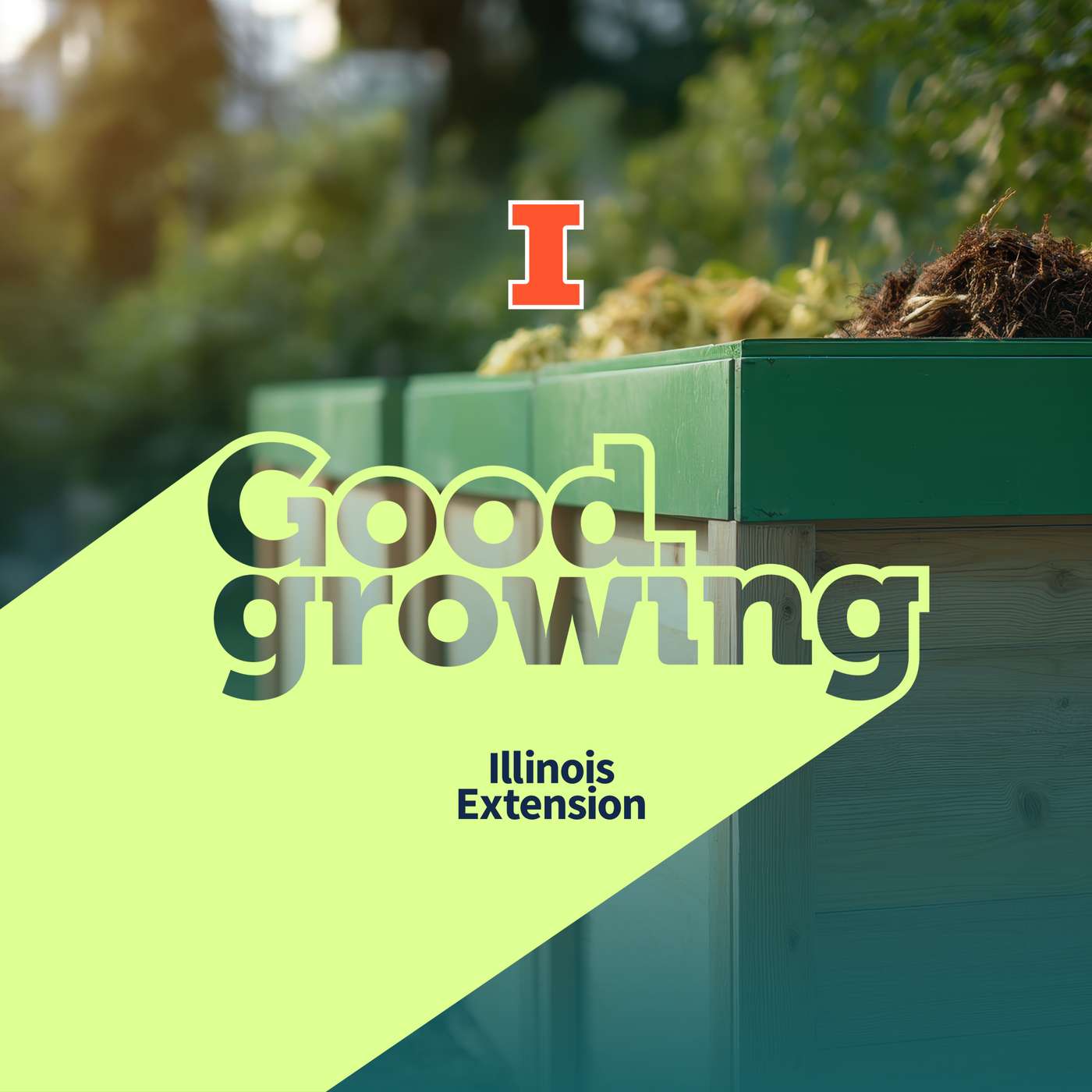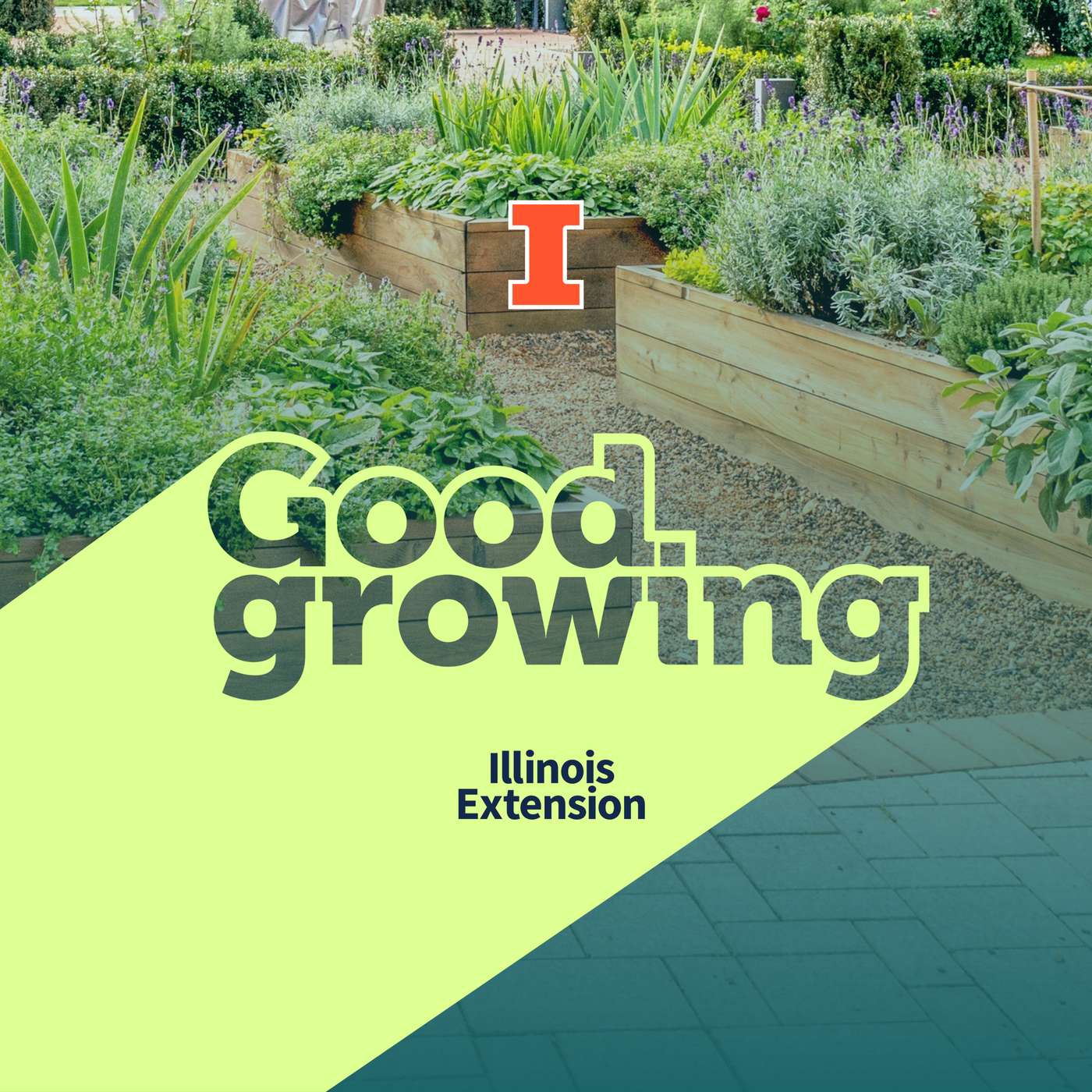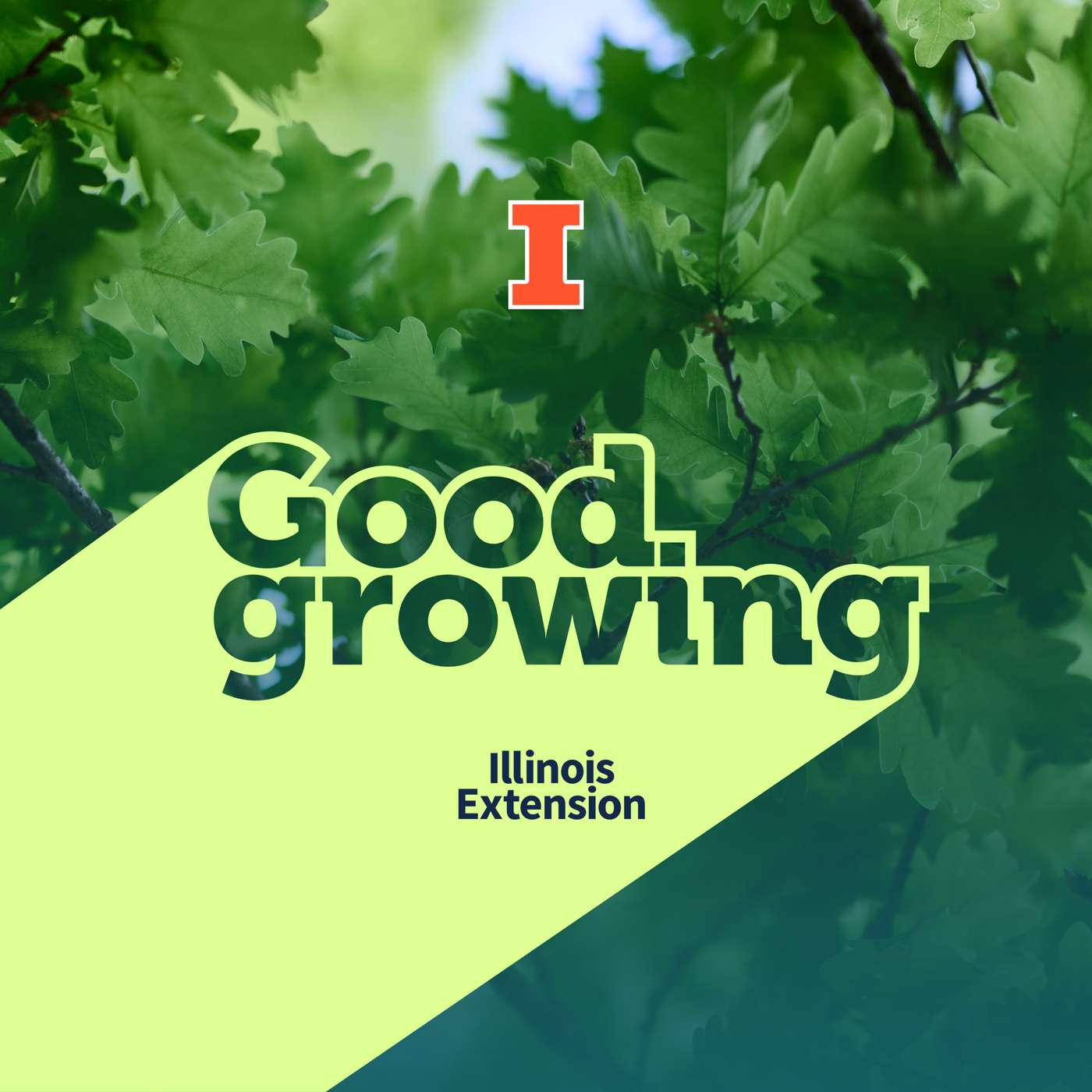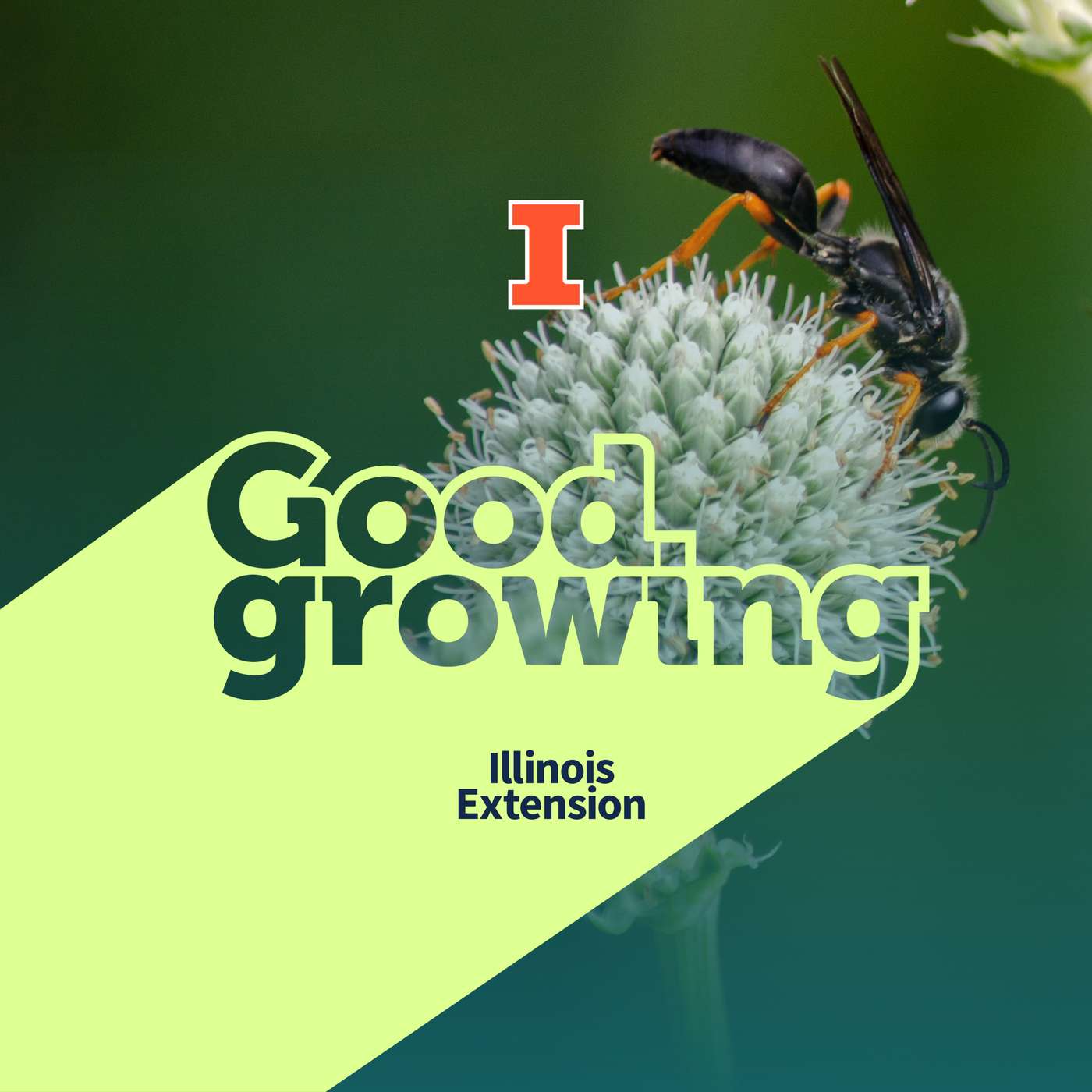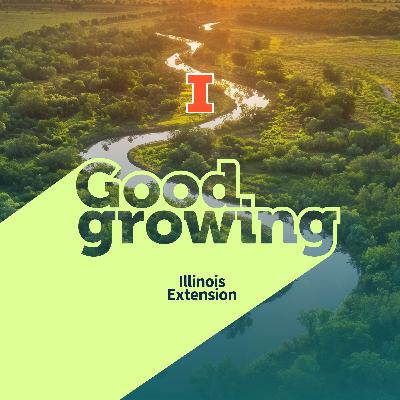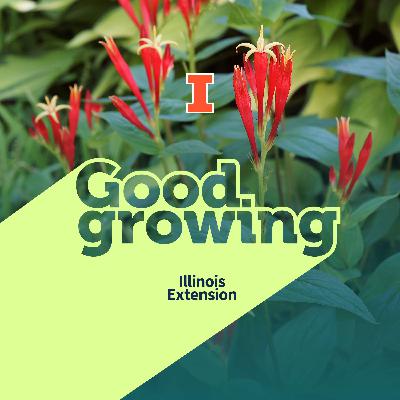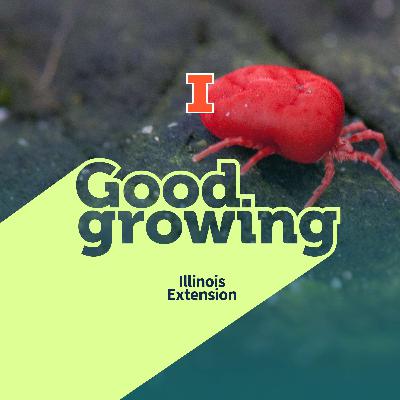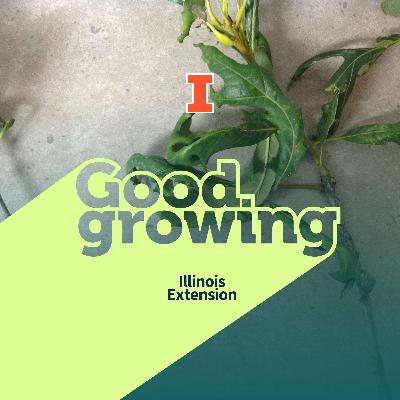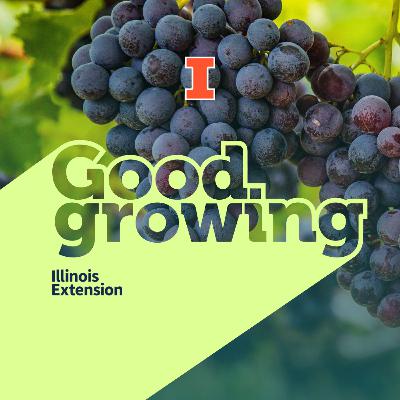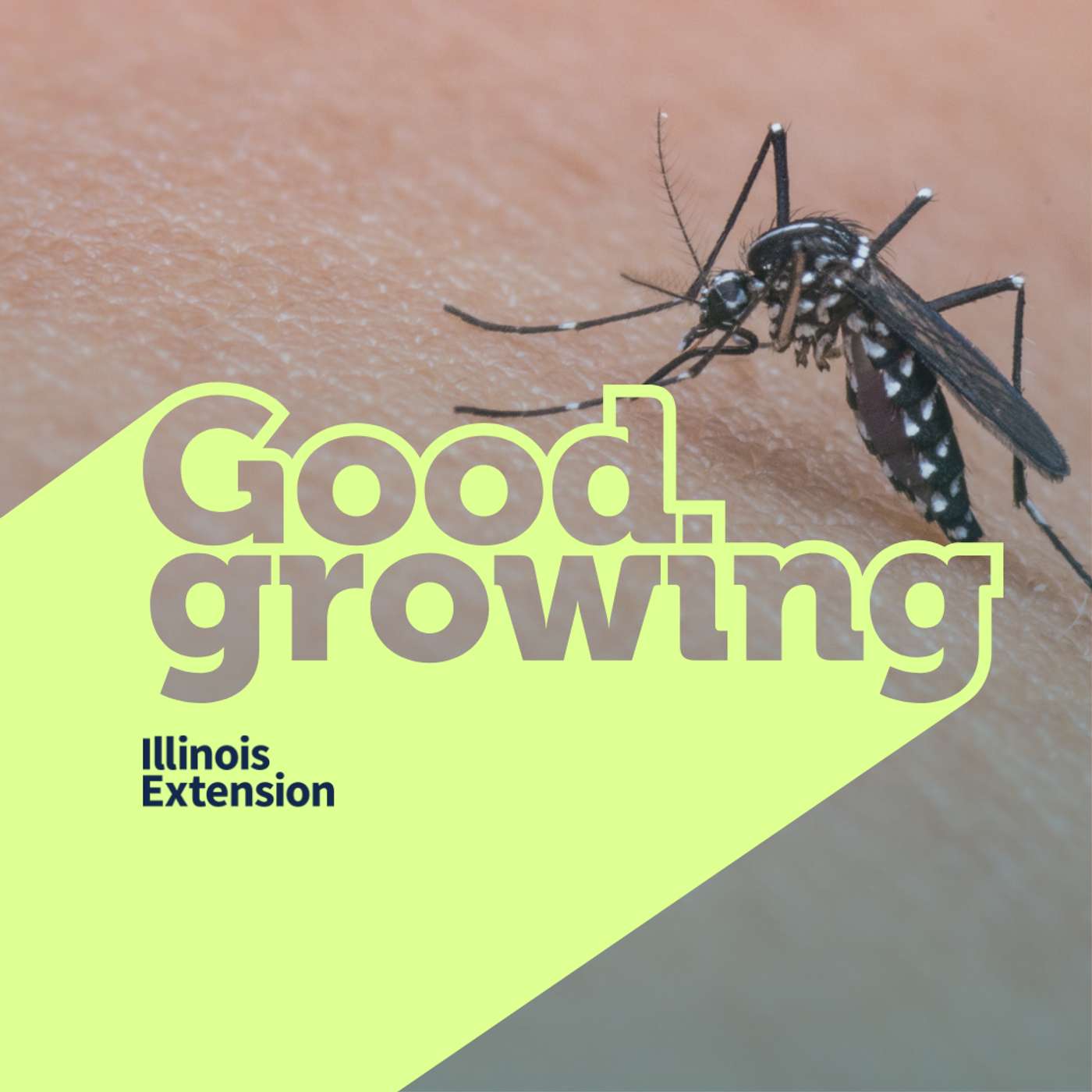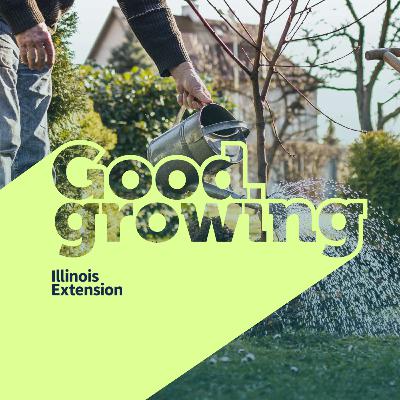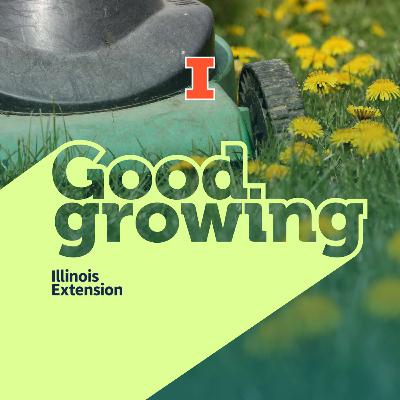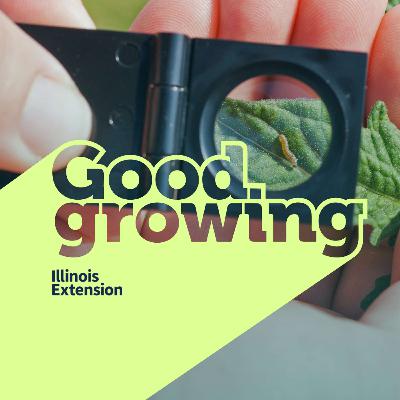Discover Good Growing
Good Growing

284 Episodes
Reverse
In this episode of the Good Growing Podcast, horticulture educator Chris Enroth from University of Illinois Extension explores the adversaries of the monarch butterfly, including the controversial practice of captive rearing.Although we do not recommend captive rearing, there may be times when it is wanted for educational purposes. Can it be done responsibly? Chris shares best practices for raising monarch caterpillars indoors. Instead of captive rearing, support habitat conservation efforts! Learn how programs like Monarch Waystations and pollinator gardens can help restore critical habitat.Watch us on YouTube https://youtu.be/Yfzxnvpco0M00:32 The dangers encountered by monarch butterflies 02:07 Predators! 02:17 Disease!03:18 A historic shift in habitat for monarch butterflies04:04 Introducing the concept of captive rearing of monarch butterflies07:17 Why captive rearing is not recommended 07:27 A loss of fitness 09:21 Artificially overpopulating an area with monarch butterflies10:38 If you are STILL going to captive rear monarch butterflies, here are some tips. 11:44 What to feed your monarch caterpillars (cats) 14:21 What type of container to use 14:57 Placement of rearing cage 15:14 Check and clean containers daily 15:42 The stages (instars) of the caterpillar 16:11 The walkabout and final molt into a chrysalis 18:19 Emergence of the adult butterfly from the chrysalis 18:51 Releasing the adult 19:00 Not everything works out with the rearing process 19:19 Don't handle monarch caterpillars 19:51 How many caterpillars are responsible for rearing?21:53 If captive rearing is discouraged, what can be done to help monarch butterflies?23:49 efforts to support monarch butterfly habitat24:32 Monarch Waystation Program29:15 Upcoming Monarch Migration Festival. Thank you and see you next week!Monarch Migration Festival, Sept 6, 2025 https://extension.illinois.edu/events/2025-09-06-11th-annual-monarch-migration-festivalXerces Society Keep Monarchs Wild https://www.xerces.org/blog/keep-monarchs-wildMonarch Butterfly Science w/ Dr. Andy Davis https://www.youtube.com/watch?v=zIt-zkivDjIMonarch Butterfly Status Update w/ Brodie Dunn https://www.youtube.com/watch?v=dmqQlyPY1TAUniversity of Illinois Extension Pollinator Pockets https://extension.illinois.edu/cfiv/pollinator-pocketsUniversity of Illinois Extension Pollinator Website https://illinoispollinators.org/Contact us! Chris Enroth: cenroth@illinois.eduKen Johnson: kjohnso@illinois.edu Check out the Good Growing Blog: https://go.illinois.edu/goodgrowingSubscribe to the weekly Good Growing email: https://go.illinois.edu/goodgrowingsubscribeAny products or companies mentioned during the podcast are in no way a promotion or endorsement of these products or companies.Barnyard Bash: freesfx.co.uk --You can find us on most podcast platforms. iTunes - https://podcasts.apple.com/us/podcast/good-growing/id1446630377 Tunein - https://tunein.com/podcasts/Gardening/Good-Growing-p1187964/ Spotify - https://open.spotify.com/show/202u3siWExE1tTqrVgtmCR Vurbl - https://vurbl.com/station/good-growing-4pljnNlUtyG/ Listen notes - https://www.listennotes.com/podcasts/good-growing-chris-enroth-cHLPMWpvEOG/ Ivy - https://ivy.fm/podcast/good-growing-167902 Castbox - https://castbox.fm/channel/Good-Growing-id4302614?country=us
In this episode, Chris and Ken delve into the complex world of composting. From their passive piles that simply sit and rot (no judgment!) to active setups that require thermometers, turning, and possibly even a chipper shredder. Learn what compost actually is (hint: it’s not soil), how to build a pile that works, and why moisture matters. Don't feed the landfill. Feed your soil!Watch us on YouTube https://youtu.be/LWrdiau0aiA Skip to what you want to know:00:37 Hey Ken! Do we compost at home?02:43 What is and is not compost?06:51 How do we go about making compost?07:09 Types of composting.10:52 Where is a good spot to locate a compost pile?14:13 How big should a compost pile be?15:09 Materials to go into a compost pile. Talking about the carbon-to-nitrogen (C:N) ratio18:27 Building your compost pile. Measuring materials and layering.20:21 Tables listing C:N ratios of different compost materials https://extension.missouri.edu/publications/g6956 22:13 Different styles of compost bins23:23 Compost bin plans https://learningstore.extension.wisc.edu/search?type=article%2Cpage%2Cproduct&q=G4020-01* https://extension.illinois.edu/sites/default/files/designs_for_composting_systems.pdf 24:53 Is it allowed to compost in your area, or what rules do you need to follow?25:23 Reduce the mass of the compost materials.27:28 Can you compost in the winter?28:54 Holding compost materials over winter for use in spring.30:27 Counter-top composter32:30 How do you know when compost is ready to be used?35:18 What's happening in the compost pile when decomposition is occurring?36:50 Tips for and tools for turning compost and measuring interior temperature41:12 Sifting Compost42:35 Ways to use your compost44:37 What moisture level should we keep our compost piles?45:25 Compost tea49:04 Compost vs. fertilizer54:13 Thank you and see you next week!Illinois Extension’s soil and composting website (includes links to soil testing labs) https://extension.illinois.edu/soil Contact us! Chris Enroth: cenroth@illinois.eduKen Johnson: kjohnso@illinois.edu Check out the Good Growing Blog: https://go.illinois.edu/goodgrowingSubscribe to the weekly Good Growing email: https://go.illinois.edu/goodgrowingsubscribeAny products or companies mentioned during the podcast are in no way a promotion or endorsement of these products or companies.Barnyard Bash: freesfx.co.uk --You can find us on most podcast platforms. iTunes - https://podcasts.apple.com/us/podcast/good-growing/id1446630377 Tunein - https://tunein.com/podcasts/Gardening/Good-Growing-p1187964/ Spotify - https://open.spotify.com/show/202u3siWExE1tTqrVgtmCR Vurbl - https://vurbl.com/station/good-growing-4pljnNlUtyG/ Listen notes - https://www.listennotes.com/podcasts/good-growing-chris-enroth-cHLPMWpvEOG/ Ivy - https://ivy.fm/podcast/good-growing-167902 Castbox - https://castbox.fm/channel/Good-Growing-id4302614?country=us
Thinking about building raised beds, but not sure where to start? Check out this week’s Good Growing Podcast as we discuss the benefits and challenges of raised bed gardening. From building materials to filling beds, get tips for construction, irrigation, and maintenance. Learn how raised beds can improve accessibility, reduce compaction, and what plants to grow in them. Watch us on YouTube: https://youtu.be/5ooWAxzir6g Skip to what you want to know: 00:48 – Welcome, Ken. How are our tomatoes looking? 03:13 - Why would we want to go through the effort to build a raised bed? 08:43 - What are some drawbacks of raised beds? 11:09 - What materials can be used to build raised beds? 09:57 – Wood: untreated, treated, logs 16:30 – Composite lumber 18:11 – Metal 20:52 – Stone/rock, bricks, and concrete 22:35 - Raised bed construction tips 28:04 - What should raised beds be filled with? 36:38 - Can you put stuff in the bottom of a raised bed so you don't have to fill it as much? 38:53 - Do you need to kill grass before filling raised beds? 40:40 - Raised bed maintenance - settling soil and irrigation 48:10 - What can be (or what do we) grown in raised beds? 55:21 - Wrap-up, thank yous, what's up next week, and goodbye! Oregon State University - Pressure-treated wood for raised bed construction: https://extension.oregonstate.edu/gardening/soil-compost/pressure-treated-wood-raised-bed-construction-willamette-valley Evaluation of substrates in constructed, raised-beds for vegetable culture: https://openscholar.uga.edu/record/12578 Contact us! Chris Enroth: cenroth@illinois.eduKen Johnson: kjohnso@illinois.edu Check out the Good Growing Blog: https://go.illinois.edu/goodgrowingSubscribe to the weekly Good Growing email: https://go.illinois.edu/goodgrowingsubscribe Any products or companies mentioned during the podcast are in no way a promotion or endorsement of these products or companies. Barnyard Bash: freesfx.co.uk --You can find us on most podcast platforms. iTunes - https://podcasts.apple.com/us/podcast/good-growing/id1446630377 Tunein - https://tunein.com/podcasts/Gardening/Good-Growing-p1187964/ Spotify - https://open.spotify.com/show/202u3siWExE1tTqrVgtmCR Vurbl - https://vurbl.com/station/good-growing-4pljnNlUtyG/ Listen notes - https://www.listennotes.com/podcasts/good-growing-chris-enroth-cHLPMWpvEOG/ Ivy - https://ivy.fm/podcast/good-growing-167902 Castbox - https://castbox.fm/channel/Good-Growing-id4302614?country=us
Ever wondered how to tell one tree from another—or why it even matters? Check out this week’s Good Growing podcast, where we dive into the magical world of tree identification with horticulture educator Sarah Vogel. From leaf shapes and bark textures to Latin names and mnemonic tricks, learn how recognizing trees can help you care for them better, diagnose problems, and deepen your connection with nature. Watch us on YouTube: https://youtu.be/_7IMFXaOqNc Skip to what you want to know: 01:20 – Welcome, Sarah! 02:28 - Why is tree identification important? 05:53 - Do you remember the first tree you learned to identify? 11:09 - What are the basics when it comes to identifying trees? 15:44 - Are there tools to help with tree ID? 22:37 - Is learning Latin names necessary? 29:30 - Any upcoming tree ID walks? 31:53 - Tree ID recap, process to identifying an unknown tree. 34:41 - Wrap-up, thank yous, what's up next week, and goodbye! Forest Trees of Illinois: https://pubsplus.illinois.edu/products/forest-trees-of-illinoisTree Owner’s Manual: http://www.treeownersmanual.info/Illinois Trees: English: https://dnr.illinois.gov/content/dam/soi/en/web/dnr/publications/documents/00000696.pdf Spanish: https://dnr.illinois.gov/content/dam/soi/en/web/dnr/publications/documents/00000702.pdfIllinois Extension - DeWitt, Macon, and Piatt Counties: https://extension.illinois.edu/dmpCommunity Tree Care Series: https://extension.illinois.edu/plants/community-tree-care-series Contact us! Chris Enroth: cenroth@illinois.eduKen Johnson: kjohnso@illinois.edu Check out the Good Growing Blog: https://go.illinois.edu/goodgrowingSubscribe to the weekly Good Growing email: https://go.illinois.edu/goodgrowingsubscribe Any products or companies mentioned during the podcast are in no way a promotion or endorsement of these products or companies. Barnyard Bash: freesfx.co.uk --You can find us on most podcast platforms. iTunes - https://podcasts.apple.com/us/podcast/good-growing/id1446630377 Tunein - https://tunein.com/podcasts/Gardening/Good-Growing-p1187964/ Spotify - https://open.spotify.com/show/202u3siWExE1tTqrVgtmCR Vurbl - https://vurbl.com/station/good-growing-4pljnNlUtyG/ Listen notes - https://www.listennotes.com/podcasts/good-growing-chris-enroth-cHLPMWpvEOG/ Ivy - https://ivy.fm/podcast/good-growing-167902 Castbox - https://castbox.fm/channel/Good-Growing-id4302614?country=us
In this candid and photo-filled episode of the Good Growing Podcast, horticulture educators Chris Enroth and Ken Johnson take you on a tour of their own backyards. You will see the good, bad, and pretty. Learn about battling verticillium wilt and jumping worms to celebrating volunteer wildflowers and thriving pollinator beds. During the show, Chris tries a cucumber melon for the first time, and Ken shares his ever-expanding front yard prairie project. They share what’s working, what’s not, and what they’ve learned during a hot, humid, and rain-soaked Illinois summer.Watch us on YouTube - https://youtu.be/RYNgQSKxXxcSkip to what you want to know:00:39 Hey Ken!01:12 The growing conditions up to this point in our 2025 gardens04:11 A dead tree and confirmed diagnosis: Verticillium wilt. Dealing with Verticillium wilt of trees and shrubs.08:37 Checking out how things are growing in Ken's backyard13:15 Chris found the invasive jumping worm in his landscape bed20:27 Checking in on Ken's vegetable garden29:16 Is this a melon or a cucumber? It's a cucumber melon!31:55 Passive tick control - tick tubes34:04 Ken's passive mosquito control - mosquito bucket of doom!36:07 What's growing along Ken's driveway?37:09 Check out our hydrangeas40:57 Ginger midsummer update45:00 Ken’s summer wildflower display - Kill your lawn!51:37 Thank yous and coming up next weekContact us! Chris Enroth: cenroth@illinois.eduKen Johnson: kjohnso@illinois.edu Check out the Good Growing Blog: https://go.illinois.edu/goodgrowingSubscribe to the weekly Good Growing email: https://go.illinois.edu/goodgrowingsubscribe Any products or companies mentioned during the podcast are in no way a promotion or endorsement of these products or companies.Barnyard Bash: freesfx.co.uk --You can find us on most podcast platforms. iTunes - https://podcasts.apple.com/us/podcast/good-growing/id1446630377 Tunein - https://tunein.com/podcasts/Gardening/Good-Growing-p1187964/ Spotify - https://open.spotify.com/show/202u3siWExE1tTqrVgtmCR Vurbl - https://vurbl.com/station/good-growing-4pljnNlUtyG/ Listen notes - https://www.listennotes.com/podcasts/good-growing-chris-enroth-cHLPMWpvEOG/ Ivy - https://ivy.fm/podcast/good-growing-167902 Castbox - https://castbox.fm/channel/Good-Growing-id4302614?country=us
Wasps often get a bad reputation for being aggressive and painful pests. However, they play important roles in our gardens. From pollination to pest control, wasps are more helpful than many people realize. Check out this week’s Good Growing Podcast to learn more about the benefits of wasps and how to safely manage them in your landscape.Watch us on YouTube: https://youtu.be/uw7BSf9kUQ0 Pollination Success Following Loss of a Frequent Pollinator: The Role of Compensatory Visitation by Other Effective Pollinators - https://doi.org/10.1093/aobpla/plx020. Yellow Jackets May Be an Underestimated Component of an Ant-Seed Mutualism - https://www.jstor.org/stable/3877985. Contact us! Chris Enroth: cenroth@illinois.eduKen Johnson: kjohnso@illinois.edu Check out the Good Growing Blog: https://go.illinois.edu/goodgrowingSubscribe to the weekly Good Growing email: https://go.illinois.edu/goodgrowingsubscribe Any products or companies mentioned during the podcast are in no way a promotion or endorsement of these products or companies. Barnyard Bash: freesfx.co.uk --You can find us on most podcast platforms. iTunes - https://podcasts.apple.com/us/podcast/good-growing/id1446630377 Tunein - https://tunein.com/podcasts/Gardening/Good-Growing-p1187964/ Spotify - https://open.spotify.com/show/202u3siWExE1tTqrVgtmCR Vurbl - https://vurbl.com/station/good-growing-4pljnNlUtyG/ Listen notes - https://www.listennotes.com/podcasts/good-growing-chris-enroth-cHLPMWpvEOG/ Ivy - https://ivy.fm/podcast/good-growing-167902 Castbox - https://castbox.fm/channel/Good-Growing-id4302614?country=us
Have you ever wondered if trees and crops can grow together and actually benefit each other? Or maybe you've heard the term "agroforestry" and aren't quite sure what it means. Check out this week's Good Growing Podcast as we dig into the world of agroforestry with MJ Oviatt from the Savanna Institute. From windbreaks and riparian buffers to growing nuts, berries, and more, learn how blending trees with agriculture can boost biodiversity, protect soil and water, and even support your bottom line! Watch us on YouTube: https://youtu.be/l0oVLH5i9Us Skip to what you want to know: 00:35 - Welcome back, Ken. What's our agroforestry experience? 02:45 - Welcome, MJ Oviatt 06:34 - What is agroforestry? Does it work in Illinois? 10:29 - Is agroforestry focused on economics? Or ecology? 14:06 - What benefits does agroforestry provide to a farm or property? 17:42 - Are there barriers that keep property owners from incorporating agroforestry? 22:52 - What kind of plants can be used for windbreaks? 27:32 - Is there a wrong way to create a windbreak? 33:12 - What are riparian buffers? What are the benefits of these? 42:47 - Does the Savanna Institute have examples of agroforestry in practice? Do you provide education for landowners? 49:31 – Savana Institute's work on hazelnuts 54:18 - MJ, what species would you want in your own agroforestry project? 57:46 - Wrap-up, thank yous, what's up next week, and goodbye!Savanna Institute: https://www.savannainstitute.org/Perennial AF Podcast: https://www.savannainstitute.org/perennialaf/MJ Oviatt: https://www.savannainstitute.org/staff-mj-oviatt/ Contact us! Chris Enroth: cenroth@illinois.eduKen Johnson: kjohnso@illinois.edu Check out the Good Growing Blog: https://go.illinois.edu/goodgrowingSubscribe to the weekly Good Growing email: https://go.illinois.edu/goodgrowingsubscribe Any products or companies mentioned during the podcast are in no way a promotion or endorsement of these products or companies. Barnyard Bash: freesfx.co.uk --You can find us on most podcast platforms. iTunes - https://podcasts.apple.com/us/podcast/good-growing/id1446630377 Tunein - https://tunein.com/podcasts/Gardening/Good-Growing-p1187964/ Spotify - https://open.spotify.com/show/202u3siWExE1tTqrVgtmCR Vurbl - https://vurbl.com/station/good-growing-4pljnNlUtyG/ Listen notes - https://www.listennotes.com/podcasts/good-growing-chris-enroth-cHLPMWpvEOG/ Ivy - https://ivy.fm/podcast/good-growing-167902 Castbox - https://castbox.fm/channel/Good-Growing-id4302614?country=us
In this Gardenbite episode of the Good Growing Podcast, Chris Enroth kicks back over the Fourth of July weekend to flash back to a 2021 chat with Extension educator Elizabeth Wahle, who declares Spigelia her all-time favorite garden plant. Why? Picture a flower dressed for Mardi Gras with scarlet red petals, golden yellow tips, and a flair that hummingbirds can’t resist.Spigelia marilandica, also known as Indian Pink or Carolina Pink, might become your new favorite native plant!Contact us! Chris Enroth: cenroth@illinois.eduKen Johnson: kjohnso@illinois.edu Check out the Good Growing Blog: https://go.illinois.edu/goodgrowingSubscribe to the weekly Good Growing email: https://go.illinois.edu/goodgrowingsubscribe Any products or companies mentioned during the podcast are in no way a promotion or endorsement of these products or companies.Barnyard Bash: freesfx.co.uk --You can find us on most podcast platforms. iTunes - https://podcasts.apple.com/us/podcast/good-growing/id1446630377 Tunein - https://tunein.com/podcasts/Gardening/Good-Growing-p1187964/ Spotify - https://open.spotify.com/show/202u3siWExE1tTqrVgtmCR Vurbl - https://vurbl.com/station/good-growing-4pljnNlUtyG/ Listen notes - https://www.listennotes.com/podcasts/good-growing-chris-enroth-cHLPMWpvEOG/ Ivy - https://ivy.fm/podcast/good-growing-167902 Castbox - https://castbox.fm/channel/Good-Growing-id4302614?country=us
In this itchy edition of the Good Growing podcast, horticulture educator Chris Enroth shares his annual run-in with one of summer’s most irritating pests—chiggers. Just in time for the Fourth of July, Chris dives into the myths, facts, and personal stories surrounding these nearly invisible arachnids. Learn what chiggers really are, how they bite, why nail polish won’t help, and what you can actually do to protect yourself. Whether you're gardening, hiking, or dodging fireworks, this Garden Bite will help you stay itch-free and informed.Watch on YouTube https://youtu.be/D1Wkcf0qQaYGood Growing Blog Post https://extension.illinois.edu/blogs/good-growing/2019-07-02-unseen-menacechiggersKansas State University https://www.ksre.k-state.edu/news-and-publications/news/stories/2025/03/entomology-chiggers-in-kansas.htmlUniversity of Missouri https://extension.missouri.edu/publications/g7398Contact us! Chris Enroth: cenroth@illinois.eduKen Johnson: kjohnso@illinois.edu Check out the Good Growing Blog: https://go.illinois.edu/goodgrowingSubscribe to the weekly Good Growing email: https://go.illinois.edu/goodgrowingsubscribe Any products or companies mentioned during the podcast are in no way a promotion or endorsement of these products or companies.Barnyard Bash: freesfx.co.uk --You can find us on most podcast platforms. iTunes - https://podcasts.apple.com/us/podcast/good-growing/id1446630377 Tunein - https://tunein.com/podcasts/Gardening/Good-Growing-p1187964/ Spotify - https://open.spotify.com/show/202u3siWExE1tTqrVgtmCR Vurbl - https://vurbl.com/station/good-growing-4pljnNlUtyG/ Listen notes - https://www.listennotes.com/podcasts/good-growing-chris-enroth-cHLPMWpvEOG/ Ivy - https://ivy.fm/podcast/good-growing-167902 Castbox - https://castbox.fm/channel/Good-Growing-id4302614?country=us
In this episode of the Good Growing Podcast, hosts Chris Enroth and Emily Swihart are joined by horticulture educator Ryan Pankau to unpack a 2024 study from the Illinois Natural History Survey. The topic? Chemical trespass—how herbicides and other pesticides are drifting into Illinois’ natural areas and impacting native ecosystems, impacting a keystone group of trees - oaks.Watch us on YouTube: https://youtu.be/44Ue4HbGS7YSkip to what you want to know: 00:33:12 Hello Emily!01:35:06 Welcome, Ryan Pankau!02:18:18 What report are we talking about? Understanding the extent and consequences of chemical trespass for Illinois ecosystems02:57:12 How has the landscape of Illinois changed historically to where we are today?10:16:15 What is chemical trespass?12:58:18 What organizations conducted this study?16:49:15 What type of data was collected? What species seemed to be most impacted?19:14:23 What is the ecological impact of pesticide trespass in our forests?24:30:24 Does this just impact trees on the edges of fields or throughout a forest?25:20:02 What did the data show in the collection samples?27:31:09 What was the percentage of chemical trespass observed?29:56:00 Can we solely rely on visual assessment to determine levels of herbicide trespass?33:32:06 What they didn't find much of - dicamba and neonics34:46:00 What does a tree that has been impacted by herbicide drift look like?40:32:17 The importance of the lab tests in this study.41:02:16 What do you do when your tree is impacted by herbicide trespass?48:50:01 Can you prevent this damage or is there a way to protect trees and gardens from being damaged?56:51:03 While there seemed to be a big focus on herbicide trespass, the study found a lot of fungicide in the later season samples. What is the impact of fungicide?1:01:12:15 Our key takeaways from this reportContact us! Chris Enroth: cenroth@illinois.eduEmily Swihart eswihart@illinois.eduKen Johnson: kjohnso@illinois.edu Check out the Good Growing Blog: https://go.illinois.edu/goodgrowingSubscribe to the weekly Good Growing email: https://go.illinois.edu/goodgrowingsubscribe Any products or companies mentioned during the podcast are in no way a promotion or endorsement of these products or companies.All photos by Chris EnrothBarnyard Bash: freesfx.co.uk --You can find us on most podcast platforms. iTunes - https://podcasts.apple.com/us/podcast/good-growing/id1446630377 Tunein - https://tunein.com/podcasts/Gardening/Good-Growing-p1187964/ Spotify - https://open.spotify.com/show/202u3siWExE1tTqrVgtmCR Vurbl - https://vurbl.com/station/good-growing-4pljnNlUtyG/ Listen notes - https://www.listennotes.com/podcasts/good-growing-chris-enroth-cHLPMWpvEOG/ Ivy - https://ivy.fm/podcast/good-growing-167902 Castbox - https://castbox.fm/channel/Good-Growing-id4302614?country=us
Roses are grown in many gardens for their large, showy, often fragrant flowers. If you grow roses, you may have noticed something eating the leaves of your plants, causing them to become unsightly. While various insects will feed on roses, one of the most commonly encountered pests is rose roseslugs. Check out this week’s Good Growing Podcast to learn more about these rose pests and how to manage them. Watch us on YouTube: https://youtu.be/Fo836_3pgl8 Contact us! Chris Enroth: cenroth@illinois.eduKen Johnson: kjohnso@illinois.edu Check out the Good Growing Blog: https://go.illinois.edu/goodgrowingSubscribe to the weekly Good Growing email: https://go.illinois.edu/goodgrowingsubscribe Any products or companies mentioned during the podcast are in no way a promotion or endorsement of these products or companies. Barnyard Bash: freesfx.co.uk --You can find us on most podcast platforms. iTunes - https://podcasts.apple.com/us/podcast/good-growing/id1446630377 Tunein - https://tunein.com/podcasts/Gardening/Good-Growing-p1187964/ Spotify - https://open.spotify.com/show/202u3siWExE1tTqrVgtmCR Vurbl - https://vurbl.com/station/good-growing-4pljnNlUtyG/ Listen notes - https://www.listennotes.com/podcasts/good-growing-chris-enroth-cHLPMWpvEOG/ Ivy - https://ivy.fm/podcast/good-growing-167902 Castbox - https://castbox.fm/channel/Good-Growing-id4302614?country=us
In this episode of the Good Growing Podcast, horticulture educators Chris Enroth and Ken Johnson dive deep into the fascinating world of milkweed—also known by its genus name, Asclepias. Whether you're a native plant enthusiast, pollinator advocate, or just curious about why this "weed" is the National Garden Bureau’s Plant of the Year, this episode is packed with insights.Watch us on YouTube: https://youtu.be/Qw24JnUOitQ Skip to what you want to know:00:46 Hey Ken! How do you say Asclepias?01:28 What's in a name? A scientific name!03:08 What is Asclepias (milkweed), and how many species of Asclepias are out in the world?04:11 History of Asclepias.07:37 Uses of milkweed outside of the garden09:30 The negative image of milkweed in the agricultural community12:02 Milkweeds for the garden. Listing the species of Asclepias native to Illinois. https://dnr.illinois.gov/education/wildaboutpages/wildaboutplants/wildaboutplantsmilkweeds.html13:28 The most common milkweeds we often see in a home landscape15:17 Our favorite milkweeds that we grow21:32 Key identifying characteristics of Asclepias23:05 Milkweed and pollination: who is the best pollinator for the job?24:41 Milkweed pollination biology https://www.nrcs.usda.gov/plantmaterials/nvpmctn12764.pdf27:39 Milkweed toxicity and monarch butterflies28:34 All the other insects using milkweed besides the monarch butterfly30:16 What is the best milkweed for monarch butterflies?30:44 https://www.frontiersin.org/journals/ecology-and-evolution/articles/10.3389/fevo.2018.00169/full Monarch Butterflies Show Differential Utilization of Nine Midwestern Milkweed Species37:35 Talking about honeyvine milkweed42:19 How do you harvest and grow milkweed seeds?45:56 Transplanting milkweed47:09 milkweed maintenance48:45 Mowing for monarchs https://extension.illinois.edu/blogs/good-growing/2018-08-28-mowing-monarchs52:08 Who decreed 2025 the year of Asclepias?53:34 Thank you and see you next week!Photos:Ken Johnson, University of Illinois ExtensionChris Enroth, University of Illinois ExtensionChris Evans, University of Illinois Extension5347031 - William M. Ciesla, Forest Health Management International, Bugwood.orgContact us! Chris Enroth: cenroth@illinois.eduKen Johnson: kjohnso@illinois.edu Check out the Good Growing Blog: https://go.illinois.edu/goodgrowingSubscribe to the weekly Good Growing email: https://go.illinois.edu/goodgrowingsubscribeAny products or companies mentioned during the podcast are in no way a promotion or endorsement of these products or companies.Barnyard Bash: freesfx.co.uk --You can find us on most podcast platforms. iTunes - https://podcasts.apple.com/us/podcast/good-growing/id1446630377 Tunein - https://tunein.com/podcasts/Gardening/Good-Growing-p1187964/ Spotify - https://open.spotify.com/show/202u3siWExE1tTqrVgtmCR Vurbl - https://vurbl.com/station/good-growing-4pljnNlUtyG/ Listen notes - https://www.listennotes.com/podcasts/good-growing-chris-enroth-cHLPMWpvEOG/ Ivy - https://ivy.fm/podcast/good-growing-167902 Castbox - https://castbox.fm/channel/Good-Growing-id4302614?country=us
Have you ever dreamed of harvesting your own grapes right from your backyard? Or maybe you have a grape plant or two and are unsure of how to care for them. Check out this week's Good Growing Podcast as we demystify the art and science of growing grapes at home with commercial agriculture specialist Dr. Elizabeth Wahle. From selecting disease-resistant cultivars to growing and training grape vines, managing pests, and more! Watch us on YouTube: https://youtu.be/AUxI1tupXNI Skip to what you want to know: 00:23 - Welcome, Ken. What's your favorite way to consume grapes? 02:17 - Welcome, Elizabeth. 03:47 - What are the key things someone should consider before planting grapes in their backyard? 05:40 - Are there specific grape varieties that are best suited for beginners or small spaces? 08:27 - Can people grow grapes in containers? 10:55 - How big will a typical grape plant get? 12:01 - How important is climate and soil type when choosing grape varieties? 16:31 - When is the best time of year to plant grapevines? 19:11 - What kind of support structures do grapevines need (e.g., trellises, arbors)? 22:25 - Herbicides and the problems they can cause on grapes 24:10 - Do we need more than one type of grape for pollination? Are they self-pollinating? 25:26 - What are the most common mistakes new growers make? 29:07 - How do you prune grapevines, and why is it so important? Plus, a few more common grape growing mistakes. 34:31 - What pests or diseases should backyard growers watch out for? 40:20 - Growing grapes organically in Illinois 43:10 - What should someone do if their vines aren't producing fruit? 45:53 - Are there any low-maintenance grape varieties - "plant and forget"? 49:03 - How do you know when grapes are ready to harvest? 50:56 - Any tips for storing or preserving grapes after harvest? 54:15 - Elizabeth, what's your favorite way to consume grapes, what is your favorite grape variety, and why? 56:56 - Any final words of encouragement for someone thinking about starting their grape-growing journey? 58:00 - Wrap-up, thank yous, what's up next week, and goodbye! Contact us! Chris Enroth: cenroth@illinois.eduKen Johnson: kjohnso@illinois.edu Check out the Good Growing Blog: https://go.illinois.edu/goodgrowingSubscribe to the weekly Good Growing email: https://go.illinois.edu/goodgrowingsubscribe Any products or companies mentioned during the podcast are in no way a promotion or endorsement of these products or companies. Barnyard Bash: freesfx.co.uk --You can find us on most podcast platforms. iTunes - https://podcasts.apple.com/us/podcast/good-growing/id1446630377 Tunein - https://tunein.com/podcasts/Gardening/Good-Growing-p1187964/ Spotify - https://open.spotify.com/show/202u3siWExE1tTqrVgtmCR Vurbl - https://vurbl.com/station/good-growing-4pljnNlUtyG/ Listen notes - https://www.listennotes.com/podcasts/good-growing-chris-enroth-cHLPMWpvEOG/ Ivy - https://ivy.fm/podcast/good-growing-167902 Castbox - https://castbox.fm/channel/Good-Growing-id4302614?country=us
Tired of being a mosquito magnet? In this episode of the Good Growing podcast, horticulture educators Chris Enroth and Ken Johnson bust common mosquito myths and dive into what really works to keep those pesky biters at bay. From citronella candles and bug zappers to the viral “Bucket of Doom,” learn which repellents are backed by science—and which ones are just buzz. Whether you're planning a backyard BBQ or just want to enjoy your garden in peace, this episode is your go-to guide for mosquito control that actually works.Watch us on YouTube https://youtu.be/dpAHAqJ2WhM Skip to what you want to know:00:40 Hey Ken!03:20 What makes people attractive to being bitten by mosquitoes?05:55 Mosquito control that doesn't work07:50 Purple Martins10:40 Mosquito sonic repellents. 11:59 Bug zapper lights16:49 A pan of soapy water.17:49 Using mouthwash21:38 Stuff that kind of works21:44 Mosquito-repelling plants24:46 Citronella candles26:51 Mosquito control that can work27:03 Fogging/spraying an area30:56 Mosquito bucket of doom!36:30 Habitat modification41:47 Stay inside44:03 Wear light colored, loose-fitting clothing45:44 CO2 TrapsContact us! Chris Enroth: cenroth@illinois.eduKen Johnson: kjohnso@illinois.edu Check out the Good Growing Blog: https://go.illinois.edu/goodgrowingSubscribe to the weekly Good Growing email: https://go.illinois.edu/goodgrowingsubscribeAny products or companies mentioned during the podcast are in no way a promotion or endorsement of these products or companies.Barnyard Bash: freesfx.co.uk --You can find us on most podcast platforms. iTunes - https://podcasts.apple.com/us/podcast/good-growing/id1446630377 Tunein - https://tunein.com/podcasts/Gardening/Good-Growing-p1187964/ Spotify - https://open.spotify.com/show/202u3siWExE1tTqrVgtmCR Vurbl - https://vurbl.com/station/good-growing-4pljnNlUtyG/ Listen notes - https://www.listennotes.com/podcasts/good-growing-chris-enroth-cHLPMWpvEOG/ Ivy - https://ivy.fm/podcast/good-growing-167902 Castbox - https://castbox.fm/channel/Good-Growing-id4302614?country=us
Peonies are a springtime showstopper, fragrant, full, and beloved in gardens across the world. Check out this week’s Good Growing Podcast and explore the history of peonies, their flower forms, and tips for growing, dividing, and relocating them. We also discuss why ants are drawn to their buds, what might be keeping your peonies from blooming, and how to make the most of their short but spectacular bloom season. Watch us on YouTube: https://youtu.be/_CB0qzCxJ5Q Skip to what you want to know: 00:33 - Welcome, Ken. How do you pronounce peony? Peonies and the rain. 02:12 - History and types of peonies 07:27 - Peonies as cut flowers 13:48 - Bloom times and cultivars 17:02 - Flower forms 22:20 - Why do we see ants on peony flowers? 25:38 - Peony diseases 30:33 - Moving and dividing peonies 35:52 - Breeding your own peonies 40:57 - The story of Peonydale 47:23 - Why aren't my peonies blooming? 50:17- Wrap-up, thank yous, what’s up next week, and goodbye! Read more about it: Peony flower forms: https://americanpeonysociety.org/learn/herbaceous-peonies/flower-types-anatomy/ Peonydale and the Wettengel Family Story: http://wimuseum.org/peonydale-and-the-wettengel-family-story/ Contact us! Chris Enroth: cenroth@illinois.eduKen Johnson: kjohnso@illinois.edu Check out the Good Growing Blog: https://go.illinois.edu/goodgrowingSubscribe to the weekly Good Growing email: https://go.illinois.edu/goodgrowingsubscribe Any products or companies mentioned during the podcast are in no way a promotion or endorsement of these products or companies. Barnyard Bash: freesfx.co.uk --You can find us on most podcast platforms. iTunes - https://podcasts.apple.com/us/podcast/good-growing/id1446630377 Tunein - https://tunein.com/podcasts/Gardening/Good-Growing-p1187964/ Spotify - https://open.spotify.com/show/202u3siWExE1tTqrVgtmCR Vurbl - https://vurbl.com/station/good-growing-4pljnNlUtyG/ Listen notes - https://www.listennotes.com/podcasts/good-growing-chris-enroth-cHLPMWpvEOG/ Ivy - https://ivy.fm/podcast/good-growing-167902 Castbox - https://castbox.fm/channel/Good-Growing-id4302614?country=us
It’s late spring, which means buffalo gnats are back and biting. This week on the Good Growing Podcast, we take a look at buffalo gnats, where they live, their lifecycle, what you can do to avoid their bites, and more! Watch us on YouTube: https://youtu.be/i0Hq-hZ6fFU Contact us! Chris Enroth: cenroth@illinois.eduKen Johnson: kjohnso@illinois.edu Check out the Good Growing Blog: https://go.illinois.edu/goodgrowingSubscribe to the weekly Good Growing email: https://go.illinois.edu/goodgrowingsubscribe Any products or companies mentioned during the podcast are in no way a promotion or endorsement of these products or companies. Barnyard Bash: freesfx.co.uk --You can find us on most podcast platforms. iTunes - https://podcasts.apple.com/us/podcast/good-growing/id1446630377 Tunein - https://tunein.com/podcasts/Gardening/Good-Growing-p1187964/ Spotify - https://open.spotify.com/show/202u3siWExE1tTqrVgtmCR Vurbl - https://vurbl.com/station/good-growing-4pljnNlUtyG/ Listen notes - https://www.listennotes.com/podcasts/good-growing-chris-enroth-cHLPMWpvEOG/ Ivy - https://ivy.fm/podcast/good-growing-167902 Castbox - https://castbox.fm/channel/Good-Growing-id4302614?country=us
Join Chris Enroth and Ken Johnson, horticulture educators with University of Illinois Extension, as they dive into the most pressing spring gardening questions. From getting seedlings ready for the great outdoors to how to water those newly planted Arbor Day trees and more, we've got some timely tips for the spring garden.Watch us on YouTube https://youtu.be/ymjesr8Z24ESkip to what you want to know:00:56 Hey Ken!01:29 How do I prepare my seedlings for planting outside? What does it mean to harden them off?03:48 What if the garden isn't ready for planting, but our plants are outgrowing their pots?06:20 How do I water my newly planted trees from Arbor Day? Specifically, Canadian hemlock.10:45 Small caterpillars are eating all the needles off my Mugo pine! What are they, and how do I stop them?14:31 Why are my blackberries dying back? It seems like the frost keeps killing them.21:02 What do you do about a bumblebee nest near your front door?24:03 Xerces Society moving bumblebee nest https://xerces.org/bumble-bees/nesting-overwintering 25:34 Illinois State Beekeepers Association https://www.ilsba.com/contact.html 25:58 Swarmed Website https://beeswarmed.org/ 26:30 The difference between a bumblebee and a yellow jacket wasp27:06 Rabbits are eating my arborvitae. What can I spray to stop them?31:07 So long and thank you!31:44 But wait, there's more! How do you tell the difference between a caterpillar and a sawfly?Contact us! Chris Enroth: cenroth@illinois.eduKen Johnson: kjohnso@illinois.edu Check out the Good Growing Blog: https://go.illinois.edu/goodgrowingSubscribe to the weekly Good Growing email: https://go.illinois.edu/goodgrowingsubscribeAny products or companies mentioned during the podcast are in no way a promotion or endorsement of these products or companies.Barnyard Bash: freesfx.co.uk --You can find us on most podcast platforms. iTunes - https://podcasts.apple.com/us/podcast/good-growing/id1446630377 Tunein - https://tunein.com/podcasts/Gardening/Good-Growing-p1187964/ Spotify - https://open.spotify.com/show/202u3siWExE1tTqrVgtmCR Vurbl - https://vurbl.com/station/good-growing-4pljnNlUtyG/ Listen notes - https://www.listennotes.com/podcasts/good-growing-chris-enroth-cHLPMWpvEOG/ Ivy - https://ivy.fm/podcast/good-growing-167902 Castbox - https://castbox.fm/channel/Good-Growing-id4302614?country=us
The calendar has turned to May, which means it’s time for No Mow May. No Mow May was started to help pollinators, but does No Mow May work well in Illinois? Check out this week’s Good Growing Podcast to learn more about what No Mow May is, whether or not it’s a good option for us in Illinois, other ways we can support pollinators, and more! Watch us on YouTube: https://youtu.be/3FWjduDGmGM Skip to what you want to know: 00:29 - Welcome, Ken. Where has spring gone? 03:06 - What is No Mow May? 06:57 - Some problems with No Mow May 13:44 - Dandelions, are they good for pollinators? 19:16 - What can we do to provide early-season resources for pollinators? 35:26- Wrap-up, thank yous, what’s up next week, and goodbye! Read more about it: Good Growing Blog - It’s almost May; is it time to stop mowing? Fitness costs and benefits of a non-native floral resource for subalpine solitary bees Amino Acid Content of Dandelion Pollen, a Honey Bee (Hymenoptera: Apidae) Nutritional EvaluationIllinois Pollinators website Contact us! Chris Enroth: cenroth@illinois.eduKen Johnson: kjohnso@illinois.edu Check out the Good Growing Blog: https://go.illinois.edu/goodgrowingSubscribe to the weekly Good Growing email: https://go.illinois.edu/goodgrowingsubscribe Any products or companies mentioned during the podcast are in no way a promotion or endorsement of these products or companies. Barnyard Bash: freesfx.co.uk --You can find us on most podcast platforms. iTunes - https://podcasts.apple.com/us/podcast/good-growing/id1446630377 Tunein - https://tunein.com/podcasts/Gardening/Good-Growing-p1187964/ Spotify - https://open.spotify.com/show/202u3siWExE1tTqrVgtmCR Vurbl - https://vurbl.com/station/good-growing-4pljnNlUtyG/ Listen notes - https://www.listennotes.com/podcasts/good-growing-chris-enroth-cHLPMWpvEOG/ Ivy - https://ivy.fm/podcast/good-growing-167902 Castbox - https://castbox.fm/channel/Good-Growing-id4302614?country=us
From getting exercise to growing your own food to a sense of accomplishment, there are many benefits to having a vegetable garden. However, sometimes, we run into space restrictions and give up hope of having our own vegetable garden. But does that have to be the case? Tune in to this week’s Good Growing Podcast to learn about ways we can grow vegetables in small spaces, like cultivar selection, growing in pots, seasonal planting, and more! Watch us on YouTube: https://youtu.be/lVDite6vvGE Skip to what you want to know: 00:30 - Welcome, Ken. More plants for small spaces and our experiences with gardening in small spaces 03:18 - Happy Arbor Day 04:54 - Gardening in small spaces - selecting smaller plants 09:47 - Growing in containers 23:00 - Fruit plants for containers 28:10 - Using trellising to save space 34:30 - Growing in raised beds to save space 37:28 - Planting seasonally 40:03 - Incorporating food crops into landscaping (edible landscaping) 43:52 - Wrap-up, thank yous, what’s up next week, and goodbye! Pictures:Watermelon Cal Sweet Bush - All-American SelectionsPepper Pot-a-peno - All-America Selections Contact us! Chris Enroth: cenroth@illinois.eduKen Johnson: kjohnso@illinois.edu Check out the Good Growing Blog: https://go.illinois.edu/goodgrowingSubscribe to the weekly Good Growing email: https://go.illinois.edu/goodgrowingsubscribe Any products or companies mentioned during the podcast are in no way a promotion or endorsement of these products or companies. Barnyard Bash: freesfx.co.uk --You can find us on most podcast platforms. iTunes - https://podcasts.apple.com/us/podcast/good-growing/id1446630377 Tunein - https://tunein.com/podcasts/Gardening/Good-Growing-p1187964/ Spotify - https://open.spotify.com/show/202u3siWExE1tTqrVgtmCR Vurbl - https://vurbl.com/station/good-growing-4pljnNlUtyG/ Listen notes - https://www.listennotes.com/podcasts/good-growing-chris-enroth-cHLPMWpvEOG/ Ivy - https://ivy.fm/podcast/good-growing-167902 Castbox - https://castbox.fm/channel/Good-Growing-id4302614?country=us
Join Chris Enroth and Ken Johnson on the Good Growing podcast as they dive into the world of Integrated Pest Management (IPM). In this episode, they explore the foundational principles of IPM, including cultural, mechanical, biological, and chemical controls. Learn how to identify and manage pests effectively while promoting a healthy and sustainable garden environment. Discover practical tips for scouting, diagnosing plant problems, and using pesticides responsibly. Plus, hear fascinating insights about lightning-resistant trees and the role of beneficial insects in your garden. Whether you're a seasoned gardener or just starting out, this episode is packed with valuable information to help you master IPM and keep your garden thriving.Watch us on YouTube https://youtu.be/5hYQSQSRhaUSkip to what you want to know:00:36 Hey Ken!01:13 Can trees benefit from lightning strikes?05:40 Diving into and defining I.P.M. - Integrated Pest Management06:16 What is a pest? It all depends (mostly).11:17 Where do we begin our IPM strategy?20:12 The foundation of an IPM structure (system).21:13 Management techniques used in IPM (the pillars).21:35 How do you scout for IPM?23:50 Using good plant culture to avoid growing issues.29:33 Controlling pests mechanically/physically.34:29 Using other living things to help control plant pests.40:04 Can you buy beneficial insects to be released in a garden to help control pests?44:34 The fourth pillar of an IPM program - pesticides50:25 Synthetic vs. biorational (organic) pesticides57:42 Categorizing pesticides - contact vs. systemic1:04:20 How do we use pesticides to limit the impact on bees?How some tropical trees benefit from being struck by lightning: evidence for Dipteryx oleifera and other large-statured trees https://nph.onlinelibrary.wiley.com/doi/epdf/10.1111/nph.70062Contact us! Chris Enroth: cenroth@illinois.eduKen Johnson: kjohnso@illinois.edu Check out the Good Growing Blog: https://go.illinois.edu/goodgrowingSubscribe to the weekly Good Growing email: https://go.illinois.edu/goodgrowingsubscribeAny products or companies mentioned during the podcast are in no way a promotion or endorsement of these products or companies.Barnyard Bash: freesfx.co.uk --You can find us on most podcast platforms. iTunes - https://podcasts.apple.com/us/podcast/good-growing/id1446630377 Tunein - https://tunein.com/podcasts/Gardening/Good-Growing-p1187964/ Spotify - https://open.spotify.com/show/202u3siWExE1tTqrVgtmCR Vurbl - https://vurbl.com/station/good-growing-4pljnNlUtyG/ Listen notes - https://www.listennotes.com/podcasts/good-growing-chris-enroth-cHLPMWpvEOG/ Ivy - https://ivy.fm/podcast/good-growing-167902 Castbox - https://castbox.fm/channel/Good-Growing-id4302614?country=us
Comments
 United States
United States

